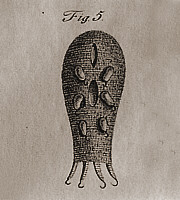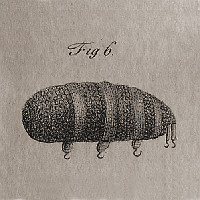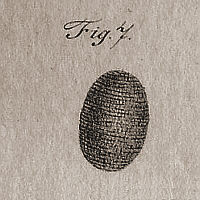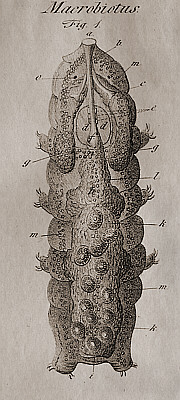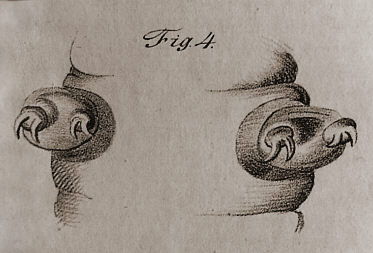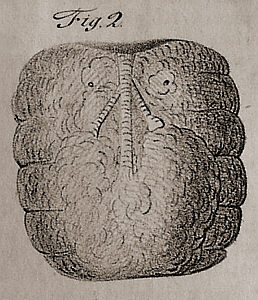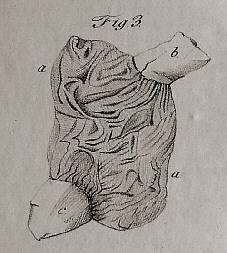When revived by means of destilled water or rain water not all of them
come back to active life. Often they remain dead, in particular when being
dried alone on a glass surface; nevertheless even some of those have been
perfectly revived and I have observed that they were able to deposit
eggs from which youngsters emerged within three weeks.
The animal belongs to the crustaceae und should be characterized as follows:
Macrobiotus: Corpus elongatum, depresso cylindricum, in decem segmenta
distinctum. Pedes octo, alternis segmentis a quarto ad decimum affixi.
Caput antennis destitutum, oculi duo.
M. Hufelandii: Corpore minimo 1/24'''- 1/3''' longo, flavo cinereo,
pedibus quadrangulatis.
For those among the gentlemen of the audience who want to check the revival ability
of the animals, similar as with Vibrio and Furcularia, I have added a small
package of sand and dry material, which has been kept in dry state since
May 2nd, 1829. A small quantity of the material, about the volume
of two pin heads has to be flooded with a drop of destilled water and
then can be investigated under the microscope; it will then be possible
to follow the process of swelling and shape variation until to
first crawling movements and in the end, swimming away."
Comment: no wonder that the conservative scientific authorities were
slighty jealous and suspiciously followed this smart demonstration by Schultze.
As a consequence the authorities presented a counter argument in the same issue
of Isis by Oken . Even today we understand that this comment had to
be longer than the original report ;-)
The editors have the honour to quote from a letter by Prof. Ehrenberg
the following highly interesting notes commenting on the previous
report:
"Prof. Retzius from Stockholm brought along from Breslau a portion of
the gutter sand which had been distributed by Professor Schultze from Greifswald
at the scientists' meeting with the claim that the phenomenon of the revival
of dried rotifers might be observed by means of the sample. One of the animals
revived by water is being called Furcularia rediviva by Mr Prof. Schultze,
and the other Macrobiotus Hufelandii. He considers them as two yet unknown species.
The fact, as resented by Mr Prof. Schultze, though well known since along time,
is being interpretated in a way which is new for me and should be checked with
thanks by all scientists. Nevertheless the two individuals were not at all
new for me. What was called Furcaria rediviva apparently are two species
of my genus Philodina; they are to be considered as Philodina erythrophthalma,
which I have shown in my first paper about small volume structures
and Philodina roseola which I have characterized in the second paper
and the intestine of which I have shown as well in this publication.
By the way the Furcularia rediviva by Lamarck to which the author seems to refer,
as can be seen from Müllers drawing even is a species of another genus, which
in my opinion has to be regarded as Rotifer vulgaris.
As far as the second animal is concerned, I have not been able to find it
in the sand sample. But I suspect from the description of Mr Retzius and Mr Carus
both of whom have been present at the demonstration that it also shows an
animal already known to me. When I showed my drawings to them they agreed
that it was the same as mine. I have held a lecture last year for the local Society
of Naturalists which featured the bizarre evolution of a new animal. This
is in preparation for print in "Schriften". I called the respective animal
Trionychicum ursinum, it is of a maggot-like, long shape. It has 8 plump feet,
each of which equipped with 3 claws and a short conical proboscis with two inner
jaw parts or teeth on a thick, spherical throat. The thick, simple intestine
with a long and thin oesophagus which I had had filled with colorants is very similar
to those of the rotifers (Hydatina), but the two stomach glands are and the rotifer
organs are missing, whereas it has two considerable black eyes in the center of the head
(possibly neck eyes).
The most strange fact is that it deposits its big eggs in its own skin during moulting,
and as a consequence takes along a simple thick bag with eggs on its way (similar
to a cyclops). One can see the shapes of 4 to 6 or eight legs and claws at the
egg bag. The youngsters are able to find their way out of the eggshell themselves
and have eight feet as well, in fact they look very similar as the adults.
I was not able to identify males and females and I do not know the anatomy of
the various systems within this organism.
This strange animal, living freely in mud, seems to be related to the
Lerneae where I would place it within the system of animals until further
evidence will help to classify it more safely. The actual typical length is 1/6 line,
sometimes 1/4'''. The size of the eggs is 1/36''', the length of the youngsters
1/24''', so a size range between 1/24 ''' and 1/4''' has to be noted.
It is now up to Mr Prof. Schultze to check whether the Macrobiotus described by him
is the same animal as already described by me, as it is important to identify any
synonyms. The animal observed by me is unable to swim.
As this report has not convinced me that desiccated animals of no matter what
species might revive after death I will try to encourage further investigations
of this interesting topic and at the same time would like to add some of my own
results. As Prof. Retzius urged me to publish a comment I would like to ask the
editors to place my comment close to the original reports when it will be printed.
Numerous experiments which I have made with resprect to the revival of thoroughly
dried infusoria never yielded a positive result. The species investigated by me
were: Rotifer vulgaris, Philodina erythrophthalma, Hydatina senta, Brachionus urceolaris,
Euglena sanguinea, Euglena viridis, Monas pulvisculus, moreover Anguillula fluviatilis,
which I do no more consider to be a member of the infusoria group. I still do
have big amounts of dried microorganisms from earlier experiments.
I have made casual observations of almost all rotifers investigated by me.
The carefully planned experiments, not on mass samples but on individual
animals never revealed any miracles. I have learnt by isolation and by direct
investigation of individual rotifers that they have a rather long life as I have
reported already elsewhere. Single rotifer individuals of any species which were dried
on a slide revived seldom after two hours never after 12 or more hours, most
many of them ended as fragments. In combination with plant detritus by which
they were surrounded, in particular between Oscillatoria I have seen rotifer organ
movements of rotifer species in the strict sense and Philodinas, but never
encountered this with Hadytina, Brachionus, Euglena or Monas. From this I
concluded that those more muscular species had not been dead. After
a fortnight I had recorded no return to movement though I think
that in an environment protected from desiccation a slower vital activity
might be maintained for one month or more.
According to Mr professor Schultze's claim the sand sample with the dried
animals was more than three years old. So I was very eager to learn which
factor might have supported and preserved the vital functions in this case.
I noticed immediately that all those Philodina coming back to active life
had not an empty stomach but an intestine filled with green particles.
I looked for the source of those green particles in the sample and found
many fine well-preserved threads the shape of which resembled those particles
which I had found in the intestine of the rotifes. Moreover I have seen eggs
deposited freely close to the animals and animals of very different size.
Comment: please note that Ehrenberg now goes over to sudden attack.
As I do not believe in marvels beyond those step-by-step processes which
can be observed in nature I would like to explain the interesting reports about
the revival of rotifers which were kept dry for more than three years as follows:
The revival seems to be a deception. The rotifers were neither dead nor
benumbed, they didn't even live for such a long time. Those animals which
had contracted to a kind of egg-shape when surrounded by a slimy not completely
dry environment might continue to take food for some time as they are
still able to eat with their jaws protruding from the laterally situated mouth.
From my early experiments moreover has to be concluded that poor nutrition tends
to prolong the lifetime of the animals and to slow down the reproduction.
It seems to be much more realistic not to believe in miracles but to assume
that those animals continue feeding and egg deposition as long as they are surrounded
by a slightly wet, viscous medium which is sufficient to preserve minimum
internal humidity and nutrition.
Because of this the seemingly revived animals were not those that dried
three years ago, but their great-grandsons. Many larvae of insects live in
seemingly dry media but still have some kind of local wetness around them.
As those rotifers seemingly dried for three year came back to perfect
movement and coordinated use of limbs within half an hour it must be assumed
that they never had completely lost this ability but were only a bit restricted.
It is no contradiction when those freshly wetted animal concretions show no
trace of movement in the first moment, as active Philodina and Rotifera,
when being disturbed, contract to a spherical shape and often maintain this state
without interior or exterior movement for half an hour.
The sudden excess of the long-awaited water might be irritating at first and it
might take some time until the animal can make use of the regained liquid element."
In spite of his long comment the famous and respected professor Ehrenberg was wrong.
Today we know that Prof. Schultze's view of the experiment was correct:
in fact the tardigrades are able to slow down their live activity very close to zero
and can survive poor environmental conditions in dry state for at least several
years. So the revived animals are not the 'great-grandsons' of the animals as
Ehrenberg assumed but exactly those individuals that had been dried a few years
before.
In the next issue of the Water Bear web base we will have a look at a series
of photographs which documents how a completely dry and seemingly dead
water bear comes back to active life again within 15 minutes, just by means
of a small droplet of water, exactly as described by professor Schultze already
in the year 1834.
|
![[Title fragment 1.1]](t1_1.gif)
![[Title fragment 1.2]](t1_2e.gif)
![[Title fragment 1.3]](t1_3e.gif)
![[Title fragment 3.1]](t3_1.gif)
![[Title fragment 3.2]](t3_2.gif)
![[Title fragment 3.3]](t3_3e.gif)
![[Title fragment 1.1]](t1_1.gif)
![[Title fragment 1.2]](t1_2e.gif)
![[Title fragment 1.3]](t1_3e.gif)
![[Title fragment 3.1]](t3_1.gif)
![[Title fragment 3.2]](t3_2.gif)
![[Title fragment 3.3]](t3_3e.gif)
![[Blick in Okens Isis]](d_f0.jpg)
